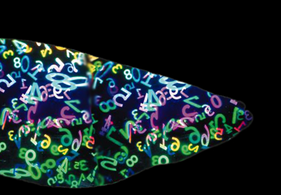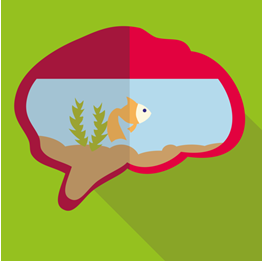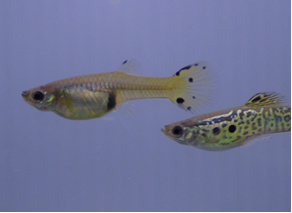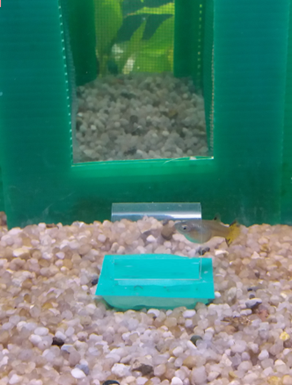Research
NUMERICAL ABILITIES - Numerical abilities have traditionally been considered a human prerogative, strictly related to symbolic language and culture. However, in last decades an increasing number of studies has shown that non-human animals possess some degree of numerical competence.
 This ability to discriminate between quantities can be useful in several contexts in nature to enhance individual survival and fitness, for instance to optimize food intake in foraging decisions, to reduce predation risk or to regulate intergroup interactions based on number of opponents.
This ability to discriminate between quantities can be useful in several contexts in nature to enhance individual survival and fitness, for instance to optimize food intake in foraging decisions, to reduce predation risk or to regulate intergroup interactions based on number of opponents.
Our research aims at investigating numerical abilities in non-human animals to assess similarities and differences in numerical competence among vertebrates, humans included. Indeed, the study of numerical abilities in animals allows to investigate numerical systems without any influence of language and culture, representing a unique methodological tool for understanding our non-symbolic numerical abilities.
We are mainly focused on fish numerical abilities but in recent years we extended our investigation to mammals (dogs, horses, wolves), reptiles (lizards) and amphibians (frogs) to better understand the role of ecology and phylogeny on numerical abilities. On the whole we observed a similar performance in distantly-related species tested in different experimental contexts, supporting the idea of a core number system shared by all vertebrates and inherited by a common ancestor.
VISUAL ILLUSIONS - It is well-known that our visual system simultaneously processes several pieces of information about the environment, such as size, shape, colour or movement of objects. However, visual information is often ambiguous and our brain is required to quickly encode such information and provide an understandable picture of the reality. With respect to this topic, visual illusions have been commonly used to understand the mechanisms underlying our visual perception.
 Modern neuroscience provided us detailed information on the photoreceptors and the brain circuits supporting vision in other species. However, physiological and neuro-anatomical studies alone cannot tell us whether the overall perception of static and dynamic events is similar among vertebrates. Our research group uses visual illusions as a tool to compare visual perception of human and non-human animals both by using training procedures and by observing their spontaneous behaviour in the presence of illusory patterns.
Modern neuroscience provided us detailed information on the photoreceptors and the brain circuits supporting vision in other species. However, physiological and neuro-anatomical studies alone cannot tell us whether the overall perception of static and dynamic events is similar among vertebrates. Our research group uses visual illusions as a tool to compare visual perception of human and non-human animals both by using training procedures and by observing their spontaneous behaviour in the presence of illusory patterns.
We have recently found interesting similarities in the perception of visual illusions in distantly related species: guppies and zebrafish, for instance, are sensitive to the Rotating Snake illusion, a powerful motion illusion. Guppies also seem to have a human-like perception of brightness illusion. These evidence suggest the existence of similar perceptual systems in fish and primates. However, in our studies we found inter-specific differences among vertebrates. For instance, dogs and lemurs are not sensitive to the Delboeuf illusion, a size illusion reported in humans and apes. The perception of Solitaire illusion also seems to be different in human, monkeys and fish.
The route is still long. We now plan to collect further information with other species and other visual illusions in order to draw a better picture of similarities and differences in the visual perception of animals.
BEHAVIOURAL LATERALISATION - Cerebral lateralization refers to the functional specialization of the two sides of the brain for sensory, motor, and cognitive functions. In humans, many important functions such as language, face recognition and fine control of hand (handedness) are strongly lateralized.
 During the last three decades functional differences between the left and right hemispheres have been documented in many other species. In fish lateralization can be studied without using invasive method. Fish in fact have laterally placed eyes and complete cross of visual fibres and therefore stimuli seen on one side of the body are analysed almost exclusively by the contralateral side of the brain. This causes evident behavioural asymmetries that can be easily studied in laboratory.
During the last three decades functional differences between the left and right hemispheres have been documented in many other species. In fish lateralization can be studied without using invasive method. Fish in fact have laterally placed eyes and complete cross of visual fibres and therefore stimuli seen on one side of the body are analysed almost exclusively by the contralateral side of the brain. This causes evident behavioural asymmetries that can be easily studied in laboratory.
We investigate the mechanisms responsible for individual differences in laterality. In particular we study the role of genetic factors in determining strength and direction of asymmetries as well as the influence of prenatal factors and early experience in modulating the development of laterality.
We are also interested to investigate the ecological advantages and disadvantages of having a functionally asymmetric brain in order to determine the selective forces that contribute to maintenance of individual variation of laterality in populations.
SEX DIFFERENCES - One of the oldest questions in human psychology is whether men and women differ in cognitive abilities. Some studies have suggested male advantage in spatial tasks and female advantage in verbal tasks. These differences might have evolved as a consequence of ecological sex differences in the evolutionary past of our species.
 However, some authors have argued that the cognitive abilities of men and women are substantially equal and that differences in cognitive tasks might be explained by cultural factors. Sex differences in cognitive abilities have also been reported in some non-human animals such as monkeys, rodents, and few bird species. Research on non-human species potentially allows to control for cultural differences and to test hypothesis on the ecological causes of sex differences in cognition.
However, some authors have argued that the cognitive abilities of men and women are substantially equal and that differences in cognitive tasks might be explained by cultural factors. Sex differences in cognitive abilities have also been reported in some non-human animals such as monkeys, rodents, and few bird species. Research on non-human species potentially allows to control for cultural differences and to test hypothesis on the ecological causes of sex differences in cognition.
Fish show remarkable inter-sexual variability in the ecological niche they occupy and in their behaviour. This variability causes the two sexes to face different cognitive challenges, which in turn are expected to favour the evolution of different cognitive abilities in males and females. We test this possibility by comparing male and female fish in different tasks, such as mazes to assess spatial learning, visual discrimination learning, numerical discrimination, cognitive flexibility and problem solving. These tasks are based on the observation of fish behaviour in natural-like situations or on the adoption of training procedures.
Our results seem to indicate that in many cognitive tasks, males and females show comparable cognitive abilities, but that in some specific types of tests, such as those measuring spatial abilities or cognitive flexibilities, the two sexes differ.
INHIBITORY CONTROL - Executive functions have only recently started to be explored in animals. In humans, inhibitory control affects performance in a number of cognitive tasks and individual differences, predicts substance abuse, academic performance and career success, and ultimately affects health and longevity.
 We are studying inhibitory control in fish using different paradigms, reversal learning, time discounting tasks and detour-reaching tasks. In one detour-reaching tasks, the cylinder test, guppies have recently shown to perform better than many mammals and birds, which suggests that a large brain is not a prerequisite for an efficient inhibitory motor control.
We are studying inhibitory control in fish using different paradigms, reversal learning, time discounting tasks and detour-reaching tasks. In one detour-reaching tasks, the cylinder test, guppies have recently shown to perform better than many mammals and birds, which suggests that a large brain is not a prerequisite for an efficient inhibitory motor control.
We are now studying how inhibitory control changes during ontogeny, whether it is affected by experience and whether it varies across fish species with different ecological specialization.





